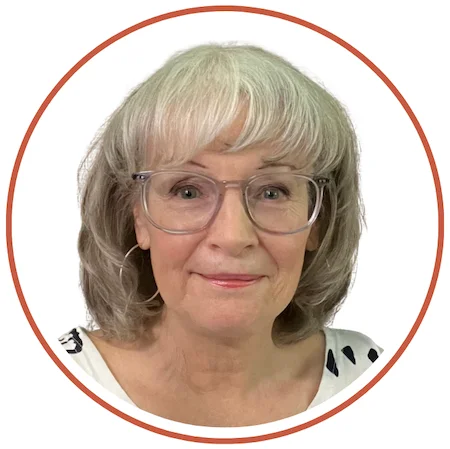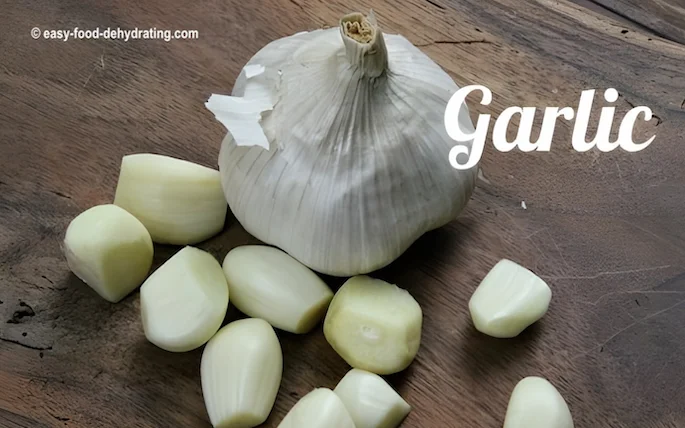- Home
- How To Dehydrate Vegetables
- How To Dehydrate Garlic
How to Dehydrate Garlic:
Elephant- or Regular-Size!
How to Dehydrate Garlic:
Elephant- or Regular-Size!

Susan Gast | Author and blogger at Bored Boomers, Beesville Books, A New Sober You and Easy Food Dehydrating
Thanks for stopping by to learn how to dehydrate garlic. It's easy when you use Elephant garlic, often called Mammoth Garlic! As the name implies, it's much bigger than regular bulbs, like four times bigger!

Oddly enough, elephant garlic is milder in taste than its smaller counterpart. Kinda like peppers, right? The smaller they are, the hotter they are.
Frequently Asked Questions:
Top question, not surprisingly is: How to dehydrate garlic?
Top question, not surprisingly is: How to dehydrate garlic?
Keep reading the page you're on to learn all about how to dehydrate garlic, whether its the mammoth- or regular garlic.
Can you dry garlic chutney?
Can you dry garlic chutney?
Yes, you can dehydrate garlic chutney to create a flavor-packed spice blend that stores well long-term. Here's how:
Ingredients:
- 2 cups prepared garlic chutney
- 1⁄4 tsp salt
Instructions:
- Line dehydrator trays with parchment paper. Spread chutney paste evenly in a thin layer, less than 1⁄4 inch thick.
- Dehydrate at 145°F for 6 to 8 hours, until completely dried out. Scrape purée every few hours with a spatula to break it up and flip over.
- The dehydrated chutney will form brittle flakes. Allow to fully cool after dehydrating, then break up any chunks into smaller pieces.
- Add salt to the dried chutney and pulse in a spice grinder or blender until it forms a fine powder.
- Store garlic chutney powder in an airtight container for up to 1 year. Add to curries, stir frys, dips, breads, etc! Just watch portions - a little goes a long way.
Adjust the recipe based on your preferred level of garlic intensity. Feel free to incorporate other seasonings too like onion, and red chili.
How do you make dehydrated garlic chips?
How do you make dehydrated garlic chips?
Making crispy dehydrated garlic chips is easy and adds lots of flavor. Here's how:
Ingredients:
- Fresh garlic cloves, peeled
- Olive oil or vegetable oil
- Salt (optional)
Instructions:
- Select fresh, firm garlic cloves. Peel off the outer skin and slice cloves very thin - about 1/8 inch thick.
- In a bowl, toss garlic slices with a little oil - about 1 tsp per cup of sliced garlic. Add a pinch of salt if desired.
- Arrange garlic slices in a single layer on dehydrator trays without overlapping.
- Dehydrate at 125°F for 6 to 10 hours, flipping halfway through. Garlic is done when slices are shrunken down and brittle.
- Cool completely before storing. Place garlic chips in an airtight container for up to 3 months.
Enjoy garlic chips as a crispy, intensely flavored garnish for pasta dishes, salads, soups, and more! Their shelf-stable crunch makes them endlessly versatile in the kitchen.
For best results, slice garlic very uniformly so pieces dry at the same rate. Rotate your dehydrator trays periodically for even drying. Get creative with added spice blends before dehydrating!
What are the Different Types of Garlic?
There are several different types of garlic that you can grow. Some of the most popular varieties include:
Softneck Garlic
Softneck garlic is a type of garlic that is easy to grow and store, has a mild flavor, and is often used in cooking.
Hardneck Garlic
Hardneck garlic is a type of garlic that has a strong flavor and is typically used in pickling or roasting.
Elephant Garlic
Elephant garlic is a type of garlic that is actually a member of the leek family. Elephant garlic has a milder flavor than traditional garlic as mentioned above.
And if you're wondering what on earth "softneck" and "hardneck" means, here's some info.: Softneck garlic has a flexible stem (makes sense) that can be braided for storage!
This type also produces more cloves per bulb than hardneck garlic. And hardneck garlic has a more rigid stem and has a stronger flavor than softneck garlic. So now you know.

Garlic Nutrition Info.
VITAMINS: Vitamin A, Vitamin C, and Vitamin B6, followed by Choline. There are trace amounts of Vitamin K, Folate, Niacin, Thiamine, Riboflavin, and Pantothenic Acid.
MINERALS: Potassium, Phosphorus, and Calcium, followed by Iron and Manganese. There are trace amounts of Zinc, Copper, and Selenium, and contains Omega-3 and Omega-6 fatty acids.
Garlic is great for tons of savory recipes: Soups and stews, and Italian dishes of all types!
How to Dehydrate Garlic
- Peel the bulb and separate the cloves and cut them into 1/8" slices—a mandoline slicer does a fine job of this for the elephant/mammoth bulbs—just watch your fingers, please! With regular (small) cloves, carefully use a paring-type knife!
- Arrange the slices on your food dehydrator trays, making sure the slices don't touch or overlap.
- Turn on your food dehydrator and set the temperature between 125°F and 135°F (or per your food dehydrator's instructions).
💡 Tip: Use our Fahrenheit to Celsius converter here on our site!
- It will be brittle when fully dried and stores well in a small Mason jar, I just crumble it up when adding it to my soups, etc.
- Drying time: between 6-12 hours.
- Please remember to rotate your trays for even drying.
 Thinly sliced Elephant Garlic on Nesco dehydrator tray
Thinly sliced Elephant Garlic on Nesco dehydrator trayJust a Quick Note...
If you're sensitive to handling raw garlic, please check out my 10 Tips for Handling Spicy Garlic here, prior to dehydrating it!
Air Ventilation Warning
You may also wish to have
your windows OPEN or put the A/C on
while you're dehydrating onions or garlic... as
the powerful odor
can certainly circulate throughout the entire house!
If
you ABSOLUTELY LOVE onions and garlic,
it's not such a bad thing, but if you don't...
just sayin'!
Air Ventilation
Warning
You may also wish to have
your
windows OPEN or put the A/C on
while you're dehydrating onions or
garlic... as
the powerful odor
can certainly circulate throughout
the entire house!
If
you ABSOLUTELY LOVE onions
& garlic, it's not such a bad thing,
but if you don't... just sayin'!
When Dehydrating Garlic—
Heed the Air Ventilation Warning Above!
When dehydrating garlic, watch out for strong odors as mentioned earlier.
Either you LOVE garlic, or you DON'T!
When
Dehydrating Garlic—
Heed the
Air Ventilation
Warning Above!
When dehydrating garlic, watch out for strong odors as mentioned earlier. Either you LOVE garlic, or you DON'T!

Grind Dehydrated Garlic to use as Garlic Salt
Did you know, you can grind up dehydrated garlic to make garlic powder? Just add equal amounts of salt to the ground powder and you now have homemade Garlic Salt.
NOTE: While dehydrating your garlic, consider dehydrating onions at the same time if you've got a spare dehydrator tray or two available! In other words, don't mix garlic and onions with, say, apples, when dehydrating—unless you WANT your APPLES to taste like GARLIC or ONIONS!!
TIP: If you're out on a date, make sure you both eat this pungent veggie. You'll thank me later for that tip!
Dehydrating garlic is an odorous job... so please run your range hood vent (if you have one) and place your dehydrator as close to the vent hood as possible. Doing so will help enormously to take the garlic odor out of the kitchen and away from your pets' sensitive noses and nervous systems— garlic aroma is poisonous to them!
Check Out Julie's SMOKED Garlic Salt... YUMMY!!
Check out Julie's great post on how she dehydrates her garlic with added sea salt!
Not only does it look amazing, but she assures us it tastes amazing too!
How to Make Toasted Garlic Bread

Garlic bread is often served as a side dish or an appetizer.
Here's a quick and easy recipe for garlic bread:
Ingredients:
- 1 loaf French bread
- 1/2 cup butter, softened
- 1/4 cup minced garlic
- 1/4 teaspoon dried parsley
- 1/4 teaspoon dried basil
- 1/4 teaspoon garlic salt
Directions:
- Preheat oven to 350°F.
- In a small bowl, mix together butter, garlic, parsley, basil, and garlic salt.
- Cut the bread loaf in half horizontally. Spread the butter mixture over the cut sides of the bread.
- Wrap the bread in aluminum foil and place it on a baking sheet.
- Bake for 10 minutes, then remove from oven and unwrap. Return to oven and bake for an additional 5 to 10 minutes, or until bread is lightly toasted.
💡 Tip: Use our Fahrenheit to Celsius converter here on our site!

A Nod to Crocodile Dundee:
If you've ever seen the movie Crocodile Dundee you'll appreciate this comment about 'regular' versus 'Elephant':
"You
call that garlic?
Now this...
(pointing to the elephant bulb)
... is
Garlic!" :-)
Best Areas for Growing Garlic
Garlic grows best in full sun and well-drained soil. Garlic prefers soil that is high in organic matter. The plants should be spaced 4 to 6 inches apart and is typically harvested in the summer or early fall.
Signs of When Garlic is Ready to Harvest...
Garlic is ready to harvest when the leaves start to yellow and the bulbs begin to form. To harvest, lift the garlic plants out of the ground with a garden fork.
Thanks for taking the time to read all about how to dehydrate garlic. Remember to run the exhaust fan on your range, or at the very least, open the windows!
Don't forget to grab your free Six Simple Steps eBook! It’s packed with tips for dehydrating everything from fruits and veggies to dog treats. Get it here.
Before You Go...
If you like the content, please give me some love by clicking on the 🩷 in the lower right hand corner (on just about all my pages). This signals to me that you find it enjoyable and useful. Thank you so much!

















